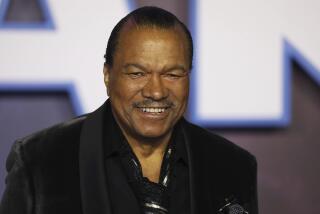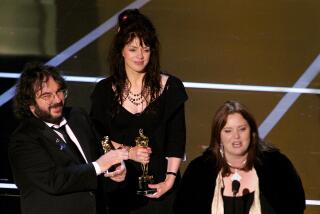‘Much Ado About Nothing’: Fun facts about Shakespeare on film
With Joss Whedon’s contemporary take on Shakespeare’s romantic comedy “Much Ado About Nothing” winning the hearts of most critics and earning a tidy $183,000 in just five theaters in its opening weekend, it’s the perfect time to brush up on your Shakespeare movies.
Here’s a no-holds-Bard look, to speak, at some fun facts at previous cinematic adaptations of Shakespeare:
The fact that no one could hear Shakespeare’s beautiful prose didn’t stop filmmakers during the silent era from adaptations of the Bard. More than 300 silent Shakespeare films -- some as short as 10 minutes -- were made between 1899 and 1911, of which only 30 to 40 survive. The first known adaptation was 1899’s “King John,” which stars legendary British Shakespearean actor Herbert BeerbohmTree (the father of Oscar-winning director Carol Reed).
PHOTOS: Shakespeare 2.0: The bard on screen
In the late 1990s, the American Film Institute restored the 1912 “Richard III,” a 55-minute French-U.S. co-production that is thought to be the first feature-length Shakespearean adaptation made.
The late Laurence Olivier and Kenneth Branagh each starred in and directed several Shakespeare adaptations. In fact, Branagh starred in and directed a well-received “Much Ado About Nothing” 20 years ago.
Olivier’s first Shakespearean film was 1936’s “As You Like It”; 70 years later, Branagh directed “As You Like It” for HBO.
Both starred in and made their feature directorial bows with acclaimed adaptations of “Henry V.” Olivier’s was released in England in 1944 and in the U.S. in 1946. He won an honorary Oscar, as well as a best actor Oscar nomination. Branagh earned a best actor and best director nomination for his 1989 take.
PHOTOS: ‘Much Ado About Nothing’ star Alexis Denisof’s favorite Shakespeare adaptations
Olivier won best actor and was nominated for best director for his 1948 version of “Hamlet,” which won the best film Oscar. Branagh’s 1996 version earned him a nomination for his adapted screenplay.
There have also been musicals inspired by Shakespeare. The 1940 film, “The Boys from Syracuse,” from the Broadway hit by Rogers and Hart, is based on “The Comedy of Errors.” And Cole Porter’s 1948 Broadway blockbuster “Kiss Me Kate,” inspired by “The Taming of the Shrew,” became a 1953 3-D movie musical with Kathryn Grayson and Howard Keel.
The most successful musical adaptation was Leonard Bernstein and Stephen Sondheim’s beloved “West Side Story,” which was based on “Romeo and Juliet.” The 1961 film, adapted from the 1957 Broadway musical, dominated the Academy Awards, winning 10 Oscars including best film, director for Robert Wise and Jerome Robbins and supporting actor for George Chakiris and supporting actress for Rita Moreno.
Two married couples who later divorced -- Douglas Fairbanks and Mary Pickford, and Elizabeth Taylor and Richard Burton -- starred in big-screen versions of “The Taming of the Shrew.” Fairbanks and Pickford’s 1929 release was not well-received, but the Taylor-Burton comedy, which Franco Zeffirelli directed in 1967, is considered one of their best collaborations.
PHOTOS: Hollywood backlot moments
In 1985, the ABC series “Moonlighting,” with Cybill Shepherd and Bruce Willis, did its own outlandish take on “Shrew” called “Atomic Shakespeare.”
James Cagney played the role of Bottom in Warner Bros’ lavish 1935 version of “A Midsummer Night’s Dream.”
There have been several offbeat “adaptations” of “The Tempest,” including the 1948 Western “Yellow Sky,” 1956’s sci-fi classic “Forbidden Planet” and Paul Mazursky’s 1982 “Tempest.”
The 1950 “Julius Caesar” starred a very young Charlton Heston as Marc Antony. He would reprise the role in a 1970 feature adaptation.
Movies inspired by “Othello” include the 1947 film noir “A Double Life,” in which Ronald Colman won a best actor Oscar playing an actor starring on Broadway as Othello who discovers the role is overtaking his own personality.
Japanese master filmmaker Akira Kurosawa also found inspiration in the Bard. His 1957 samurai classic “Throne of Blood” is based on “Macbeth.” The 1960 drama “The Bad Sleep Wells” has its roots in “Hamlet” and 1985’s “Ran” is “King Lear” set in feudal Japan.
ALSO:
Deep in thought over “Hannah Arendt”
“Much Ado About Nothing”: A DIY film project at Joss Whedon’s home
Sixteen young filmmakers named winners of Student Academy Awards
More to Read
Only good movies
Get the Indie Focus newsletter, Mark Olsen's weekly guide to the world of cinema.
You may occasionally receive promotional content from the Los Angeles Times.







